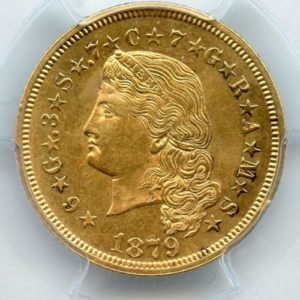Four Dollar Stella $4 (1879-1880)
At the beginning of the 19th century, America was a country filled to the brim with expansionist and global sentiments. Toward the second half of the century, now securing its borders, this sentiment shifted its focus to international trade. This brought the burgeoning democracy into what was at the time something of a global crisis in trade: too many competing coins. By 1867 there was a widespread demand for a single world coin standard and it was in this year that twenty nations agreed to a gold standard using the French franc.
However, there was dispute over on the American side of the issue as many traders in America wanted a silver, not a gold standard. In 1879, Representative John Kasson proposed two coins mixed between silver and gold to settle the dispute. One of these coins was to be a four-dollar coin consisting of 90% gold and 10% silver. Ultimately the four-dollar coin received the name “stella”, which was Latin for star and was meant to complement the eagle, as both were seen as symbols of the American nation. It was envisioned that the stella would be another base currency like the eagle and that there would be several denominations of it.
Two separate designs were created for the four dollar stella; one was made by Charles Barber and portrayed a figure of Liberty with long hair, flowing behind her. The second version was engraved by George Morgan and contrasted only slightly with Barber’s depiction in that the figure of Liberty had her hair in a bun. Each design has the proportions of metals making up the coin surrounding Liberty. On the reverse side of the coin there is a star with words that read ‘ONE /STELLA/400/CENT’, ‘E PLURIBUS UNUM’, and ‘DEO EST GLORIA’.
Unfortunately for admirers of the design and concept, the stella was never put into any long term production. As a result, there are very few remaining four dollar stellas and it’s incredibly difficult for any collector to be able to track one down. There are, however, about 425 ‘restrikes’ of the stella, which make it somewhat more common to find than the tiny number of originals, which is estimated to be around 15. Any collector who manages to find and possess one of these 15 originals should consider themselves to be exceptionally lucky.
In any case, the stella’s design and concept were never integrated into any major currencies and there was no real attempt to do so. Congress decided to make do with the existing international system and the idea of creating a competing standard coin for global trade was not entertained for long. Despite this, the four dollar stella remains a very intriguing remnant of the short but fruitful period where the United States attempted to assert itself into the question of trade around the world. For that alone, it’s easy to see why the stella and what it once stood for would interest any dedicated coin collector.
